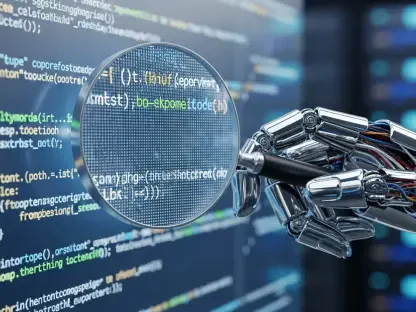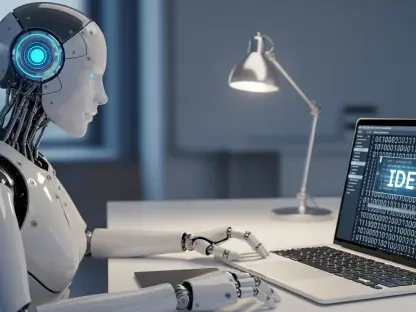The integration of Artificial Intelligence (AI) into web development and design is transforming the industry. With the AI market projected to reach $826 billion by 2030, this technology promises unprecedented efficiency and innovation. Yet, it is crucial to balance the use of AI with the irreplaceable elements of human creativity. This article explores how to achieve this balance, ensuring AI serves as an augmentative tool rather than a replacement for human ingenuity.
The Role of AI in Web Development
Enhancing Efficiency and Productivity
AI is reshaping the web development landscape by automating routine tasks. These tasks include generating layouts, creating color schemes, and ensuring accessibility compliance. By offloading these repetitive activities to AI, developers can focus more on complex, creative aspects of design. This automation leads to shorter development cycles and faster deployment of digital solutions, significantly boosting productivity. For example, AI tools can quickly generate wireframes and basic website structures based on initial design inputs. This rapid prototyping allows for quicker iterations and refinements, reducing the time it takes to bring a web project from concept to completion.
AI’s ability to streamline workflows fosters a more efficient development process. This advantage is particularly evident when dealing with large-scale projects or multiple clients simultaneously. Developers previously bogged down by repetitive coding tasks can now delegate these to AI, freeing up their schedules to tackle more intricate design challenges. The result is a dynamic development environment that prioritizes creativity without compromising on efficiency. This synergy between AI and human capabilities is paving the way for a new era in web design where productivity and innovative potential coexist harmoniously.
Promoting Accessibility and Inclusivity
One of the notable advantages of AI in web design is its role in enhancing accessibility. AI-driven tools can generate alt text for images, ensuring visually impaired users can understand the content. Additionally, voice command functionalities allow users with different abilities to navigate websites more easily. These features help create web products usable by individuals with diverse needs, promoting inclusivity. AI can analyze user behavior to personalize accessibility settings further. For instance, it can automatically adjust font sizes, contrast levels, and other interface elements based on user preferences and needs. By tailoring the user experience to each individual, AI contributes to a more inclusive web environment.
Moreover, AI’s ability to personalize user experiences can significantly enhance the accessibility of web applications. For example, AI can monitor and learn from user interactions to suggest improvements or modifications that cater to specific accessibility requirements. This adaptive approach ensures that all users, regardless of their physical or cognitive abilities, have a positive and barrier-free experience. Developers can thus leverage AI to create web environments that do not just meet basic accessibility standards but exceed them, fostering a more inclusive digital world. As technology evolves, these adaptive capabilities will likely become more sophisticated, continually improving the accessibility landscape.
The Collaborative Nature of AI and Human Creativity
Augmenting, Not Replacing Human Ingenuity
A consensus view in the industry is that AI should be seen as a collaborative tool rather than a replacement for human creativity. While AI excels at data-driven tasks, human designers bring innovation, intuition, and emotional intelligence to the table. By combining these strengths, web development can achieve new levels of excellence. Effective utilization of AI involves leveraging its capabilities for routine tasks while maintaining human oversight to handle creative and user-centric aspects. For example, designers can use AI to suggest color schemes and layouts but rely on their expertise to make final decisions that align with brand values and aesthetics.
This collaborative approach ensures that AI serves to enhance rather than undermine the unique contributions of human designers. It also helps mitigate the risk of homogenized, uninspired designs that can arise when relying too heavily on algorithmic outputs. By maintaining a balance where AI handles the technical, repetitive components, designers are free to explore more creative, innovative solutions. This synergy allows teams to deliver web products that are not only efficient and functional but also distinctive and emotionally resonant. As a result, the industry can capitalize on the best of both worlds, achieving higher standards of design quality and user satisfaction.
Maintaining Human Creativity
Despite AI’s vast capabilities, there’s a concern about the potential erosion of human creativity. AI systems operate based on existing data patterns and algorithms, which means they struggle with generating truly novel ideas. Human imagination and empathy remain irreplaceable elements that AI technology cannot replicate successfully. To preserve creativity, developers should use AI to enhance rather than dictate the design process. AI can offer suggestions and identify trends, but the final creative direction should always come from human designers. This approach ensures that web designs remain unique, innovative, and deeply connected to human experiences.
The idea of maintaining human creativity alongside AI efficiency is not just about preserving jobs but about enriching the design process. Human designers bring a depth of insight, cultural understanding, and emotional intelligence that AI cannot match. By integrating these human attributes with AI’s analytical prowess, the web development industry can foster a more holistic approach to design. This balanced integration allows for more meaningful, user-centric designs that resonate on a deeper level. In a rapidly evolving digital landscape, the nuanced touch of human creativity becomes even more crucial, ensuring that technology serves humanity rather than the other way around.
Ethical Considerations and Bias Control
Addressing Ethical Implications
AI operates based on the data it’s trained on, which means any biases in the training datasets can be reflected in its outputs. This issue raises significant ethical concerns, as biased AI tools can perpetuate societal inequalities. Developers must take a proactive approach to curate representative datasets and diligently identify and mitigate biases within AI systems. Efforts to address bias should include diverse data sources and regular audits of AI outputs. By doing so, developers can ensure that AI tools provide fair and inclusive results, contributing positively to society rather than reinforcing existing prejudices.
In addition to curating diverse datasets, developers must be vigilant about the ethical implications of AI deployment. Continuous monitoring and assessment are essential to identify any emergent biases or unintended consequences. Establishing clear ethical guidelines and fostering a culture of transparency can help mitigate risks. Collaborative efforts between ethicists, sociologists, and AI developers can provide a comprehensive framework for responsible AI usage. This interdisciplinary approach ensures that AI technologies are not only technically proficient but also socially responsible, aligning with broader ethical standards and societal values.
Ensuring Responsible AI Use
Responsible AI use involves transparency and accountability. Developers should clearly communicate how AI tools are used in web development processes and the safeguards in place to prevent bias. This transparency builds trust with users and stakeholders, showing a commitment to ethical AI practices. Moreover, involving diverse teams in AI development can help identify and address biases that might otherwise go unnoticed. By bringing different perspectives into the process, developers can create more equitable and inclusive AI-driven solutions.
Accountability also extends to the broader AI ecosystem, where companies and organizations must adhere to ethical standards and regulatory requirements. Establishing robust governance structures can ensure that ethical considerations are integrated into every stage of AI development and deployment. This includes thorough testing, regular audits, and the implementation of fail-safes to counter potential issues. Educational initiatives can further promote understanding and responsible use of AI among developers and end-users alike. By embedding ethical principles into the core of AI innovation, the industry can build a future where technological advancement and social responsibility are intrinsically linked.
Future Trends in AI-Driven Web Development
Enhanced Debugging and Testing
As AI continues to advance, it will play a more significant role in debugging and code testing. AI assistants can autonomously suggest fixes and identify bugs, easing these traditionally labor-intensive tasks. This capability will allow developers to focus more on creative and strategic aspects of their projects. AI-driven testing can also enhance the quality and reliability of web applications. By simulating various user scenarios and identifying potential issues, AI ensures that web applications perform optimally under different conditions. This proactive approach to quality assurance reduces the risk of post-launch issues and improves user satisfaction.
The role of AI in debugging and testing extends beyond mere identification of errors; it can also predict potential vulnerabilities. By analyzing code patterns and historical data, AI can forecast where issues are likely to arise, providing preemptive solutions. This predictive capability not only saves time but also enhances the resilience and robustness of web applications. As AI tools become more sophisticated, their ability to offer real-time insights and solutions will make web development processes more agile and responsive. Consequently, the industry will witness a paradigm shift where AI-driven quality assurance becomes the norm, setting new standards for reliability and user experience.
AI in Code Generation and Optimization
AI also has the potential to revolutionize code generation and optimization. AI tools can generate clean, efficient code based on mockups and design specifications, speeding up the development process. This capability enables rapid prototyping and ensures high-quality outputs from the early stages of development. Furthermore, AI-driven code optimization can identify redundancies and inefficiencies within existing codebases, streamlining performance and reducing resource consumption. These advancements offer significant advantages in terms of both development speed and application efficiency.
The benefits of AI in code generation and optimization extend to the maintenance and scalability of web applications. As projects grow in complexity, AI tools can help manage and refactor code, ensuring that it remains maintainable and scalable. This continuous optimization process can adapt to evolving technological standards and user demands, providing a dynamic and future-proof development environment. Moreover, AI’s ability to integrate seamlessly with various development frameworks and tools further enhances its utility, making it an indispensable asset in modern web development workflows. By embracing these AI-driven capabilities, developers can unlock new levels of productivity and innovation, setting the stage for a future where technology and creativity converge harmoniously.
Maintaining a Balanced Approach
To navigate the AI-driven landscape effectively, developers and designers must work toward integrating AI responsibly into their workflows. AI should enhance designers’ capabilities rather than replace them, helping to streamline workflows without sidelining human creativity. Involving designers in AI configuration ensures that the generated outputs align with brand values and the creative vision of the project. Additionally, maintaining expertise in evaluating AI recommendations against best UX practices is crucial for designs to retain a human touch. Understanding user behavior and crafting experiences that resonate emotionally are tasks best suited for human designers; ensuring these aspects remain a focal point enhances overall quality.
This balanced approach ensures that AI serves to enhance rather than undermine the unique contributions of human designers. It also helps mitigate the risk of homogenized, uninspired designs that can arise when relying too heavily on algorithmic outputs. By maintaining a balance where AI handles the technical, repetitive components, designers are free to explore more creative, innovative solutions. This synergy allows teams to deliver web products that are not only efficient and functional but also distinctive and emotionally resonant. As a result, the industry can capitalize on the best of both worlds, achieving higher standards of design quality and user satisfaction.
Conclusion
The integration of Artificial Intelligence (AI) into web development and design is revolutionizing the industry. As the AI market is projected to skyrocket to $826 billion by 2030, this technology promises to bring extraordinary efficiency and innovation to the table. However, it’s essential to harmonize the use of AI with the irreplaceable aspects of human creativity. AI capabilities, such as automating routine coding tasks, analyzing user behavior, and generating insights, make web development more streamlined and user-focused. But as we lean into AI’s potential, it’s crucial to ensure it supplements rather than supplants human creativity. Human designers and developers can use AI tools to enhance their work, offering more sophisticated and personalized web experiences. The balance lies in leveraging AI to handle repetitive tasks, leaving humans free to engage in the creative and strategic aspects that only a human touch can provide. By maintaining this balance, the industry can advance while preserving the invaluable contributions of human ingenuity. This article delves into strategies to achieve this equilibrium, ensuring AI remains an augmentative tool, not a replacement for human talent.









